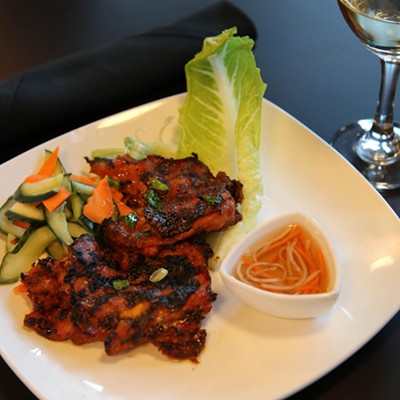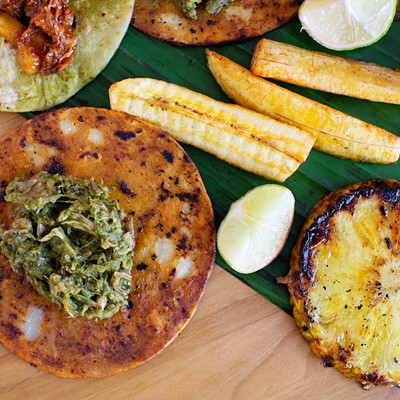Imagine, if you will, a Subway sandwich shop—but instead of making sandwiches, the folks behind the counter make sushi rolls. Welcome to How Do You Roll?, a restaurant chain that arrived in Tucson a few months back.
I find myself annoyed in many ways about How Do You Roll?, but I can't deny the fact that the place offers moderately priced sushi rolls that taste just fine—which is what really matters, I guess. So, make that the main takeaway from this review: How Do You Roll's fare tastes just fine.
Now, I shall go off on a rant about what I find annoying about How Do You Roll?
First: I loathe the décor. The main color scheme is bright orange and green. It's hideous, something that all of the flashy electronic menu boards can't hide. Plus, it's lame when a main element of the décor at a restaurant is a franchising-opportunities poster.
Second: The first HDYR in Tucson—others are reportedly planned—is called the "Speedway Park Place" location on the website. While the university-adjacent spot is indeed on Speedway, it is nowhere near Park Place. WTF?
Third: At HDYR, things like cream cheese and eggs are classified as "veggies." Um, no.
So here's how it works: You walk in, and either order one (or more) of the "featured rolls," or you design your own—just like at a Subway sandwich shop. First, you pick the wrap (the usual seaweed, $3.95, or a soy skin, $4.95), rice (white or brown) and method of rolling (normal or inside out). Second, you pick up to three "veggies" (50 cents each for more than three), including asparagus, avocado, spinach, cream cheese (ahem), cucumber, green onions, jalapeños, sprouts, egg omelet (aka tamago, and not a vegetable), tofu skin and "seasonal" options. Third, you choose the protein: beef ($1.95), chicken ($1.95), crabsticks ($1.95), regular or spicy smoked cooked salmon ($2.50), regular or spicy raw salmon ($2.50), regular or spicy raw tuna ($2.50), shrimp ($2.95), unagi (freshwater eel, $2.95) or "seasonal" fish ($2.95). Finally, you pick among toppings and varied sauces. The sauces and basic toppings (chili powder or sesame seeds) are free; if you want something more elaborate, like, say, crab mix, there is a charge (in the case of crab mix, $2.50). Various salads ($1.50 to $2.50), edamame (99 cents) and miso soup (99 cents) are also available. We tried the miso soup, and it was too watery to recommend.
Putting these rolls together is not necessarily a speedy process, especially if the restaurant is short-staffed (which was the case on one of our visits; one poor guy was working solo) or busy, but we were happy with the counter service on both of our visits.
On our dinner visit, we decided to try two of the "featured" rolls: the unagi roll ($7.95), and the "3 Alarm Roll" ($8.95). Garrett and I each decided to also build one of our own. Garrett got a seaweed/white rice roll with crawfish tails (one of the seasonal meats, apparently), jalapeños, cream cheese, avocado and sweet chili sauce; I ordered a soy/brown rice roll with shrimp, spicy tuna, tamago, green onions, avocado, smelt eggs and teriyaki sauce. We liked them both, except for one thing: I recommend the soy skin over the seaweed, because the nori we had was very tough; it made every piece gummy and difficult to chew. You'll sacrifice a bit of flavor by skipping the nori, but you'll wind up with a better mouth feel.
The featured rolls were also good, if imperfect. The unagi roll—with eel, cucumber, avocado, unagi sauce and tempura crunch—was a hit, even if the eel was a bit chewy. We also enjoyed the "3 Alarm Roll," with tuna, avocado, jalapeños, cucumbers, tempura crunch, spicy mayo, sweet chili sauce, sesame chili oil and chili powder; however, it was not the least bit spicy-hot, despite the presence of all of those pepper ingredients.
On our second visit, for a weekend lunch, we had the restaurant to ourselves. We decided to try the "Director's Cut Roll" ($9.95) with crab, eel, avocado, tofu skin, tempura crunch, wasabi mayo and unagi sauce. Other than the chewy nori, the roll hit the spot.
Less successful were our make-your-own selections, in part because I decided to be adventurous. Beef is not usually found in sushi-roll preparations, outside of some Wagyu, perhaps, and now I know why. Well, at least I know why the shredded, cooked stuff that HDYR offers is not sushi-worthy: It doesn't taste all that great, and the mouth feel is awful. My roll—with soy skin, white rice, jalapeños, cucumber, tamago, chili powder, creamy miso sauce and teriyaki sauce—was almost saved, but not quite, by the other ingredients.
Garrett's roll fared much better. With soy skin and white rice as the base, the roll included spicy tuna, baby spinach, sprouts, tofu skin and wasabi mayo. (He tried to add the crab mix as a topping, but HDYR was out of it.) While the texture was odd, thanks to the spinach and the sprouts, the roll had a nice flavor.
So, there you go: The sushi rolls at HDYR are fine, but the décor and the concept bug me. In the future, I'll be getting my sushi rolls at places that do not remind me of a Subway restaurant—but I won't object if others take a liking to How Do You Roll? Really, I won't.









